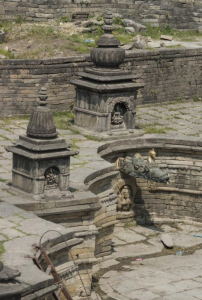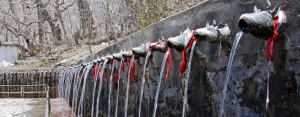The Dhunge Dhara and the Hiti System
WATER HISTORY WEDNESDAY | EDITION 07
Nepal’s intricate water supply system.
An advanced and intricate water supply system further north of India in Nepal, with their spouts known as the dhunge dhara or hiti. These spouts are the water supply that has been serving Kathmandu Valley for hundreds of years.
Dhunge dharas began during the Licchavi Kingdom (c. 400-750 CE). The first known hiti was built in Kathmandu by the grandson of Lichhavi King Mandev I in 550 CE.

Main spout of Sundhara, Kathmandu, with Garuda shrine above and Bhagiratha sculpture underneath
The dhunge dhara or hiti were part of a complex and comprehensive water supply system commissioned by the various rulers of Ancient and Medieval Nepal. They appeared as well-decorated, spouts protruding from vertical walls that poured water into a small basin below.
The spouts are located in a basin below the street level. The basin is built with both stone and brick and the floor is usually covered in stone slabs. The sides and bottom of the basin are waterproofed by a layer of kalo mato (a special type of black mud) that was common in the valley, which prevents water from the surrounding soil seeping in.
There is a low wall around the basin that helps keep surface runoff out and prevents debris from being carried in by the wind. It can be accessed via stone stairs.
Above the spout, there is typically a shrine honouring a specific deity. Most of the spouts are decorated with the shapes of the mythical makara – a creature with the snout of a crocodile, the trunk of an elephant, tusks and ear of a wild boar and the tail of a peacock. They are made mostly of stone, but some include other materials like brass, copper, gold and even wood.
Although typically there is one spout in the basin, there can be many – groups of two, three or five but the largest basin includes up to 108 (the Muktidhara in Mustang District).

Muktidhara Spouts, the Mustang District, Nepal
The Nepalese were creative in their design of the system, drawing from multiple water sources to feed their main water supply through the hitis.
The source of early hitis is mostly from the natural nearby aquifers or springs that are located near it and linked through underground supply and drainage lines.
A challenge of this early design however was the dense black mud bedrock of the valley which prevented access to the deeper underground aquifers, thus limiting their groundwater supply. As a result, later hitis were connected to a system of canals and ponds, which brought fresh water from the foothills of Kathmandu Valley to the cities.
The main sources of later hitis were rajkulos – which were long-distance water canals. The rajkulo were built to irrigate the paddy fields in the villages and facilitate drinking water in the cities supplied by hitis. The rajkulos started from the foothills of the Himalayas and fed water to the ponds and spouts located in various parts of the urban areas of Bhaktapur and Lalitpur in the Kathmandu Valley.
A third water source appeared through the collection of rainwater. Ponds collecting rainfall were constructed as a source of water. Larger ponds were constructed in the higher parts of the Kathmandu Valley settlements to feed the shallow aquifers – water seeps away from the ponds into the ground and eventually emerges from the spouts.
Some of the ponds are interconnected so that when one is filled, the overflow is directed towards another pond and so on. This chain of ponds helps to ensure a network of water bodies is created in the dry season and to help alleviate the water pressure caused by monsoon rains.
The Nepalese also implemented a form of water treatment in this system. Before the water enters the spout, it passes through a filter system, using gravel, sand, charcoal and sometimes lapsi to purify the water as it flows through. In front of the spout, there is a small pool to catch the water flowing from it. Any residual water eventually disappears into a drain and is guided towards another hiti, agricultural land or a pond (to be used for irrigation and other purposes).
Recent studies suggest that there is over 200 dhunge dhara throughout the settlements of the Kathmandu Valley today, with residents still able to use some of these features for their water supply.
The dhunge dhara, or hiti system is a fascinating system of water supply, with the integration of multi-level water sources, basic treatment and water reuse suggesting a major turning point for water technology moving into the Medieval period.




